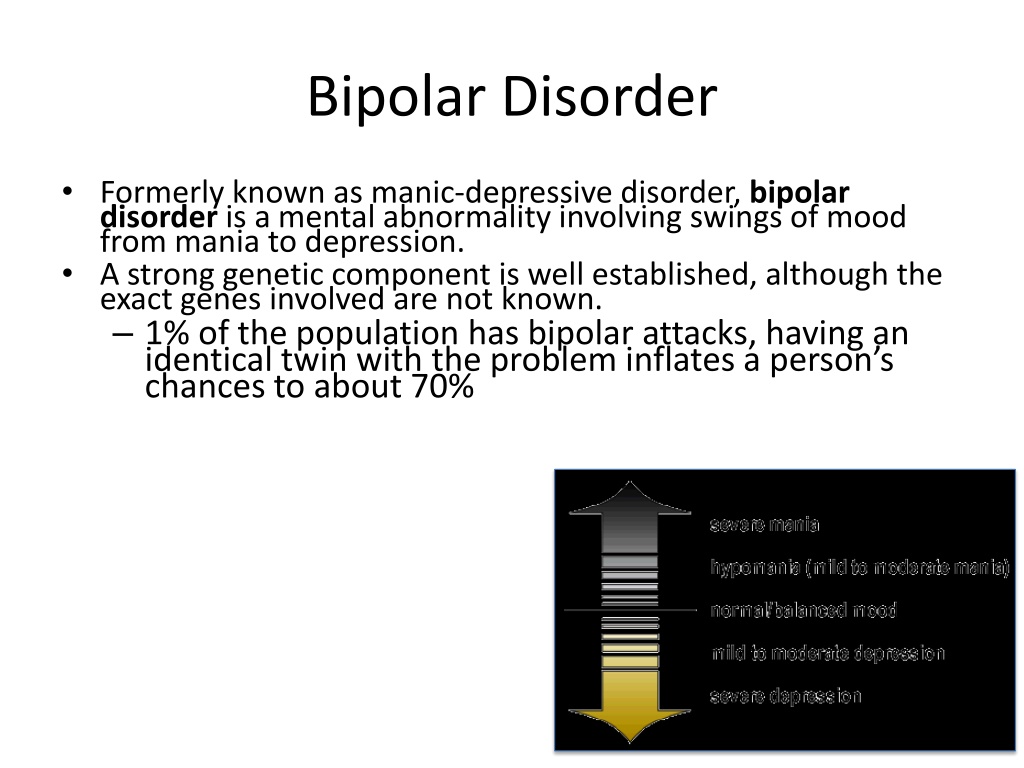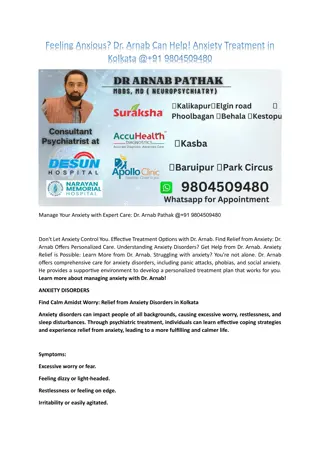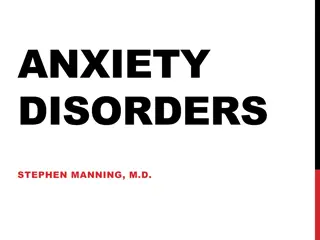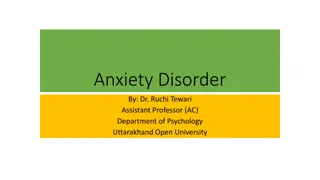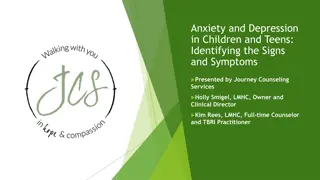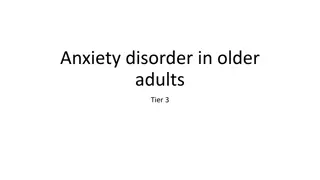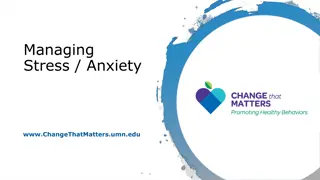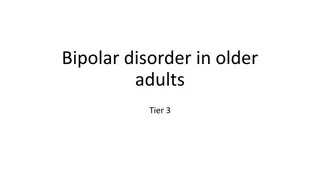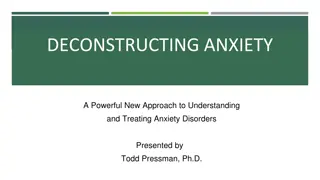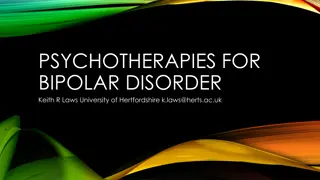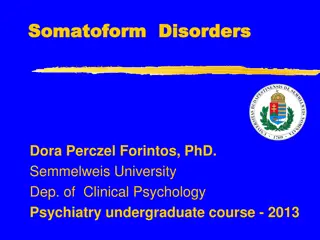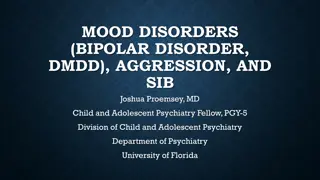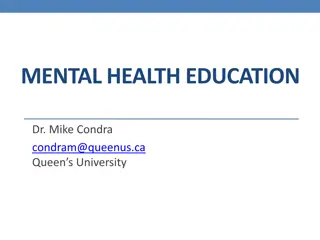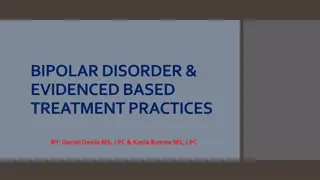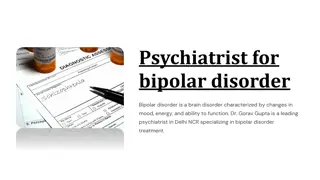Understanding Mental Health Disorders: Bipolar Disorder, Anxiety Disorders, & More
Exploring various mental health disorders such as Bipolar Disorder, Anxiety Disorders, Generalized Anxiety Disorder, Panic Disorder, and Phobic Disorders. Learn about their symptoms, prevalence, and impacts on individuals' lives.
Download Presentation

Please find below an Image/Link to download the presentation.
The content on the website is provided AS IS for your information and personal use only. It may not be sold, licensed, or shared on other websites without obtaining consent from the author. Download presentation by click this link. If you encounter any issues during the download, it is possible that the publisher has removed the file from their server.
E N D
Presentation Transcript
Bipolar Disorder Formerly known as manic-depressive disorder, bipolar disorder is a mental abnormality involving swings of mood from mania to depression. A strong genetic component is well established, although the exact genes involved are not known. 1% of the population has bipolar attacks, having an identical twin with the problem inflates a person s chances to about 70%
Anxiety Disorders Everyone has experienced some level of anxiety in their life. For some people, a spider, or a tall ladder are enough to send chills down the spine. Psychopathology anxiety is far more sever than the anxiety associated with normal life challenges.
Prevalence of Mental Disorders =Anxiety Disorder
Generalized Anxiety Disorder Generalized anxiety disorder is a psychological problem characterized by persistent and pervasive feelings of anxiety, without any external cause. May experience times when your worries don't completely consume you, but you still feel rather anxious May feel on edge about many or all aspects of your life May have a general sense that something bad is about to happen, even when there's no apparent danger. May not remember when you last felt relaxed or at ease. GAD often begins at an early age, and the signs and symptoms may develop slowly.
Panic Disorder Panic disorder is a disturbance marked by sudden and severe anxiety attacks that have no obvious connections with events in the person s life. Usually free of anxiety between panic attacks Panic attack symptoms: * Rapid heart rate * Sweating * Trembling * Shortness of breath * Hyperventilation * Chills * Hot flashes * Nausea * Abdominal cramping * Chest pain * Headache * Dizziness * Faintness * Trouble swallowing * A sense of doom
Panic Disorder Many people who suffer from panic disorder also have agoraphobia. A condition which involves panic that develops when people find themselves in situations from which they cannot easily escape: crowed places, open spaces, etc. Occurs in about 2% of people and affects women more than men.
Phobic Disorders In contrast to panic disorder, phobias involve persistent and irrational fear associated with a specific object, activity or situation. While many of us have fears, or dislikes of specific objects or situations, these only become psychopathology when they have a cause substantial disruptions in our lives. Coulrophobia
Phobias-Irrational Fears Acrophobia: Heights Claustrophobia: Enclosed spaces Hematophobia: Blood Gephyrophobia: Crossing a bridge Kenophobia: Empty rooms Cynophobia: Dogs Coulrophobia- clowns Aerophobia: Flying Entomophobia: Insects Gamophobia: Marriage Ophdophobia: Snakes Xenophobia: Strangers Melissophobia: Bees
Preparedness Hypothesis This theory suggests that we carry an innate biological tendency, acquired through natural selection, to respond quickly and automatically to stimuli that posed a survival threat to our ancestors. May explain why we develop phobias for snakes and lightening much more easily than automobiles and electrical outlets
Obsessive-Compulsive Disorder OCD is a condition characterized by patterns of persistent, unwanted thoughts and behaviors. The obsessive component consists of thoughts, images or impulses that recur or persist despite a person s efforts to suppress them.
Obsessive-Compulsive Disorder The compulsive component are repetitive, purposeful acts performed according to certain private rules, in response to an obsession. Many characters on TV and in movies have OCD: Jack Nicolson in As Good As It Gets; Monica on Friends; Monk Others?
Obsessive-Compulsive Disorder When they are calm, people with obsessive- compulsive disorder view their compulsions as senseless. However, when anxiety arises, they cannot resist performing the compulsive behavior rituals to relieve tension. OCD has a tendency to run in families A clear genetic connection Environment seems to play a factor Behavioral therapy helps many OCD sufferers
Somatoform Disorders Somatoform disorders are psychological problems appearing in the form of bodily symptoms or physical complaints such as weakness or excessive worry about disease. Conversion Disorder: A disorder marked by paralysis, weakness or loss of sensation but with no discernable physical cause. Hypochondriasis: A disorder involving excessive worry about health and disease. How a hypochondriac might see himself
Glove Anesthesia A conversion disorder in which a person can t feel their hand (B). Neurologically this is impossible because the sensory nerves of the hand and arm are organized as shown in (A) rather than (B).
Dissociative Disorders Dissociative disorders are a group of pathologies involving the fragmentation of the personality, in which some parts of the personality have become detached from other parts. Dissociative Amnesia: A psychologically induced loss of memory for personal information, like one s identity. Usually the result of a stressful situation, it is often associated with Post Traumatic Stress Disorder (PTSD).
PTSD Post Traumatic Stress Disorder dates back to 6 B.C. where reports of battlefield stress had an adverse affect on soldiers. In the past PTSD has been referred to as railway spine, shell shock, battle fatigue, traumatic war neurosis, or post-traumatic stress syndrome. Today treatment involves therapy and anti- anxiety drugs. During WWI treatment looked much different: Shell Shock/Shock Therapy
Dissociative Fugue Dissociative fugue is a combination of fugue, or flight, and amnesia. Sufferers not only suffer from a lost sense of identity, they also flee their homes, jobs and families. While most episodes last only a few hours or days, it can last longer. Heavy use of alcohol may predispose a person to dissociative fugue. While this suggest that
Dissociative Fuge The DSM-IV-TRlists four criteria for diagnosing dissociative fugue: Unexplained/ unexpected travel from a person's usual place of living along with partial or complete amnesia. Uncertainty and confusion about one's identity, or in rare instances, the adoption of a new identity. The flight and amnesia that characterize the fugue are not related exclusively to DID, nor is it the result of substance abuse or a physical illness. An episode must result in distress or impairment severe enough to interfere with the ability of the
Depersonalization Disorder Depersonalization disorder is an abnormality involving the sensation that mind and body have separated. Often times sufferers explain episodes as out of body experiences. Like all of the other dissociative disorders, depersonalization disorder occurs far more frequently following a prolonged period of stress or a traumatic event.
Dissociative Identity Disorder Once called multiple personality disorder, dissociative identity disorder is a condition where an individual displays multiple identities or personalities. Experts say this disorder appears first in childhood and may be a defensive response to abusive situations or terrifying events. Most of the emerging Fight Club is a movie about a character with sever DID.
Schizophrenia Schizophrenia is a psychological disorder involving distortions in thoughts, perceptions and/or emotions. This is the disorder people are referring to when they use terms like madness, psychosis, or insanity.
What Does it Look Like For sufferers of schizophrenia, the mind can be twisted in terrible ways. May become bleak and devoid of meaning Can become very overwhelming and filled with stimuli, hallucinations and delusions. In schizophrenia, emotions become blunted, thoughts turn bizarre, and language takes a strange turn. Take the following for example:
Sample Speech From Schizophrenic Patient The lion will have to change from dogs into cats until I can meet my father and mother and we dispart some rats. I live on the front of Whitton s head. You have to work hard if you don t want to get into bed It s all over for a squab true tray and there ain t no squabs, there ain t no men, there ain t no music, there ain t nothing besides my mother and my father who stand along upon the Island of Capri where is no ice. Well it s my suitcase sir. (Roger, 1982)
Prevalence of Schizophrenia One out of every 100 Americans, 2 million people over the age of 18-will be affected. For men, schizophrenia usually shows up before age 25, and between the ages of 25 and 40 for women. Currently, schizophrenia is the diagnosis for over 40% of patients in public mental hospitals. This may be due to the fact that there is no cure, and often times patients will need need therapy for the remainder of their lives.
5 Major Types of Schizophrenia Disorganized type: typical image of mental illness with incoherent speech, hallucinations, delusions and odd behaviors Catatonic type: a range of motor dysfunctions Stupor: long periods of coma like, motionless state Excitement: agitated and hyperactive Paranoid type: delusions and hallucinations but no catatonic symptoms and none of the incoherence of disorganized type Undifferentiated type: a catchall term for schizophrenia symptoms that are erratic and do not it into one of the other categories, but are clear symptoms of the disorder Residual type: the diagnosis for individuals who have suffered from schizophrenia, but have no major symptoms at the time
Schizophrenia Subtypes of Schizophrenia Paranoid: Preoccupation with delusions or hallucinations Disorganized: Disorganized speech or behavior, or flat or inappropriate emotion Catatonic: Immobility (or excessive, purposeless movement), extreme negativism, and/or parrotlike repeating of another s speech or movements Undifferentiated Schizophrenia symptoms without fitting one of the or residual: above types
Positive and Negative Categories Often times, researchers now simply characterize symptoms of schizophrenia into positiveand negative categories. Positive symptoms refer to active process such as delusions, and hallucinations. Negative symptoms refer to passive processes like social withdrawal.
Causes of Schizophrenia Freud originally thought schizophrenia was a result of defective parenting or repressed childhood trauma. Impact of Drugs Major tranquilizers which inhibit dopamine, can suppress the symptoms of schizophrenia Drugs that provide excess dopamine can cause schizophrenic type behaviors in healthy people.
Causes of Schizophrenia Loss of grey matter: Magnetic resonance images (MRI scanswere created after repeatedly scanning 12 schizophrenia subjects over five years, and comparing them with 12 healthy controls, scanned at the same ages and intervals. Severe loss of gray matter is indicated by red and pink colors, while stable regions are in blue. STG =superior temporal gyrus DLPFC =dorsolateral prefrontal cortex.
Causes of Schizophrenia While the exact cause of the disorder still remains somewhat of a mystery, there is very strong evidence that it has a genetic link. People who have an identical twin who suffers from schizophrenia have a 50% chance of suffering from the disorder too, even if they were raised in separate environments. Similarly, a child with one parent suffering from schizophrenia has a 13% chance of developing the disorder, but a child of two parents with the disorder has a 46% chance of developing schizophrenia.
Schizophrenia Treatments Much like the treatment for all psychological disorders, the treatment of schizophrenia has come a long way: Lobotomies Insulin Shock Therapy Current treatment for schizophrenia is usually a combination of therapy and medication: Schizophrenia Medication
Lobotomies One of the earliest treatments were lobotomies. This procedure consisted of cutting the connections to and from, or simply destroying, the prefrontal cortex.
The Process Doctors would access the frontal lobes through the eye sockets, instead of through drilled holes in the scalp. In 1945, he took an ice pick from his own kitchen and began to test the new surgical technique on cadavers.
The Process The technique involved lifting the upper eyelid and placing the point of a thin surgical instrument under the eyelid and against the top of the eye socket. A hammer was used to drive the pick through the bone, into the brain. It was then moved from side to side, severing nerve fibers connecting the frontal lobes to the thalamus.
Other Types of Disorders Most people get stuck thinking about depression and schizophrenia when they think about psychological disorders. In reality there are far more. Some of the more common, and more studied disorders are: Eating Disorders: Personality Disorders: Developmental Disorders:
Eating Disorders Of the eating disorders that exist, two are most prevalent and most studied: Anorexia nervosa: an eating disorder that causes a persistent loss of appetite that endangers an individuals health Stems from emotional or psychological reasons rather than natural causes
Eating Disorders The other common eating disorder is bulimia nervosa. Bulimia Nervosa: An eating disorder characterized by binges and purges Induced vomiting, or laxatives .6% of population affected with bulimia Up to 4.2% of females
The History ofBulimia-Nervosa It was believed that the ancient Romans used a vomitorium to rid themselves of food. Bulimia was not established as a psychological disorder until the late 1970 s. 95-85% of cases of anorexia/bulimia are women in the US (National Institute of Mental Health)
Personality Disorders Personality disorders are conditions involving a chronic, pervasive, inflexible and maladaptive pattern of thinking, emotion, social relationships or impulse control Narcissistic Personality Disorder: Grandiose sense of self importance and preoccupation with fantasies of success Antisocial Personality Disorder: Longstanding pattern of irresponsible behavior indicating lack of conscience and responsibility towards others.
Development Disorders Developmental disorders are a group of disorders that can appear at any age, but most commonly show signs during childhood. Autism: Marked by disabilities in language, social interaction and the inability to understand another person s state of mind 1 in 500 children; recent increase in cases Dyslexia: A reading disorder where letters words and numbers are perceived out of order, upside down or completely incomprehensible True account of dyslexia
